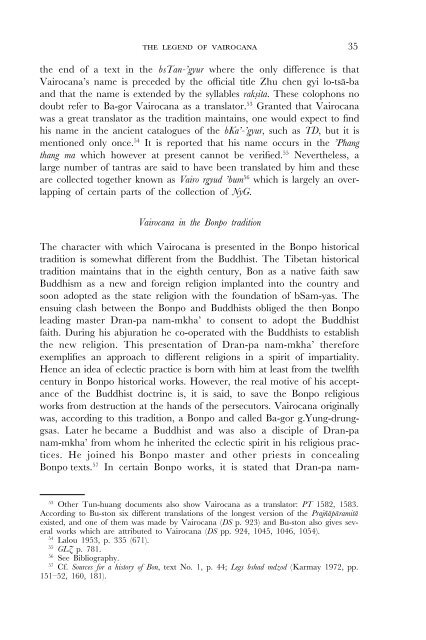Create successful ePaper yourself
Turn your PDF publications into a flip-book with our unique Google optimized e-Paper software.
the legend of vairocana 35<br />
the end of a text in the bsTan-’gyur where the only difference is that<br />
Vairocana’s name is preceded by the official title Zhu chen gyi lo-tsà-ba<br />
and that the name is extended by the syllables rakßita. These colophons no<br />
doubt refer to Ba-gor Vairocana as a translator. 53 Granted that Vairocana<br />
was a great translator as the tradition maintains, one would expect to find<br />
his name in the ancient catalogues of the bKa’-’gyur, such as TD, but it is<br />
mentioned only once. 54 It is reported that his name occurs in the ’Phang<br />
thang ma which however at present cannot be verified. 55 Nevertheless, a<br />
large number of tantras are said to have been translated by him and these<br />
are collected together known as Vairo rgyud ’bum 56 which is largely an overlapping<br />
of certain parts of the collection of NyG.<br />
Vairocana in the Bonpo tradition<br />
The character with which Vairocana is presented in the Bonpo historical<br />
tradition is somewhat different from the Buddhist. The Tibetan historical<br />
tradition maintains that in the eighth century, Bon as a native faith saw<br />
Buddhism as a new and foreign religion implanted into the country and<br />
soon adopted as the state religion with the foundation of bSam-yas. The<br />
ensuing clash between the Bonpo and Buddhists obliged the then Bonpo<br />
leading master Dran-pa nam-mkha’ to consent to adopt the Buddhist<br />
faith. During his abjuration he co-operated with the Buddhists to establish<br />
the new religion. This presentation of Dran-pa nam-mkha’ therefore<br />
exemplifies an approach to different religions in a spirit of impartiality.<br />
Hence an idea of eclectic practice is born with him at least from the twelfth<br />
century in Bonpo historical works. However, the real motive of his acceptance<br />
of the Buddhist doctrine is, it is said, to save the Bonpo religious<br />
works from destruction at the hands of the persecutors. Vairocana originally<br />
was, according to this tradition, a Bonpo and called Ba-gor g.Yung-drunggsas.<br />
Later he became a Buddhist and was also a disciple of Dran-pa<br />
nam-mkha’ from whom he inherited the eclectic spirit in his religious practices.<br />
He joined his Bonpo master and other priests in concealing<br />
Bonpo texts. 57 In certain Bonpo works, it is stated that Dran-pa nam-<br />
53 Other Tun-huang documents also show Vairocana as a translator: PT 1582, 1583.<br />
According to Bu-ston six different translations of the longest version of the Prajñàpàramità<br />
existed, and one of them was made by Vairocana (DS p. 923) and Bu-ston also gives several<br />
works which are attributed to Vairocana (DS pp. 924, 1045, 1046, 1054).<br />
54 Lalou 1953, p. 335 (671).<br />
55 GLZ p. 781.<br />
56 See Bibliography.<br />
57 Cf. Sources for a history of Bon, text No. 1, p. 44; Legs bshad mdzod (Karmay 1972, pp.<br />
151–52, 160, 181).

















